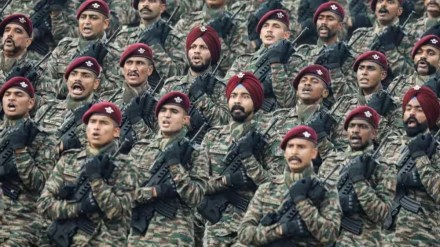Post-independence, the process of ‘theatrisation’ for the reorganization of the armed forces being undertaken is one of the most ambitious reforms for India’s armed forces, says India’s Chief of Defence Staff (CDS) Gen Anil Chauhan.
Speaking at India Defence Conclave, organised by a news portal Bharat Shakti, Gen Chauhan underscored the critical nature of consensus-building among the service Chiefs and himself to formulate a comprehensive transformation plan. In his words the transformation effort has led to the identification of nine key verticals, encompassing operations, operational-logistics, training, HR, administration, and supply chain management.
India’s second CDS Gen Chauhan in response to questions about “Theatrisation’ highlighted that while consensus is crucial, the art of compromise also holds significance in achieving collective objectives.
Speaking at the Conclave on Oct 10 in New Delhi, Chief of Army Staff Gen Manoj Pande shared details about the significant strides made by the domestic defence industry. According to him, a total of 340 indigenous defence enterprises are actively engaged in realizing 230 contracts by 2025, entailing an investment of Rs 2.5 lakh crore. Adding, the Indian defence sector has committed substantial resources to Research and Development to meet the evolving requirements of the Services.
Under Emergency Procurement provisions I to III for Capital procurement, almost 68 Contracts with an outlay of Rs 17,500 crore have fructified; and under Emergency Procurement provision IV, 73 Contracts with an outlay of Rs 10,900 crore have been concluded.
In addition to weaponry and equipment, the armed forces are actively pursuing 45 niche technologies tailored for military applications, he said.
Collaborating with leading academic institutions, Indian Army Cells are conducting specialized research in various domains. Presently, there are 120 indigenous projects in progress, dedicated to developing and assimilating these niche technologies. Notably, Technical Institutions have established Centres of Excellence, encompassing a 5G test bed, an Artificial Intelligence (AI) lab, and a Quantum lab.
Delving further into the infusion of technology, Gen Pande outlined the strategic focus areas of the armed forces. In the domain of space, the Indian Army effectively utilizes its indigenous space assets and ranks as a prominent user of satellite communication networks. Progress is underway on the Indian Army’s dedicated satellite project, GSAT-7B. The Army chief in his address conveyed to almost 49 Foreign Defence Attaches and other senior diplomats and officers that the Indian Defence Industry has the capability to produce cutting-edge military hardware with modern technologies. And urged the friendly nations and partners to avail capability building opportunities available in India.
Earlier in the evening Chief of Air Staff Air Chief Marshal (ACM) Vivek Ram Chaudhari, presented a comprehensive vision for the modernization of the Air Force, underscoring four pivotal pillars: capability development, technology assimilation, jointness, and integration.
In his address the Air Chief stated that the indigenous Light Combat Aircraft (LCA) project has played a pivotal role in creating a national aerospace ecosystem, involving 140 design agencies and 340 production agencies. Furthermore, this initiative has generated approximately 5000 jobs in the private sector. With the impending order for 97 additional LCA-MK1A aircraft by the IAF, this ecosystem is poised for further expansion, he added.
He further elaborated on the upgrade of 84 SU-30MKIs, involving an expenditure of Rs 6000 crore. This modernization endeavour is geared toward integrating indigenous content of 78 percent into 51 systems. Among these, state owned Hindustan Aeronautics Limited (HAL) will oversee the upgrade of 30 systems, the Defence Research and Development Organisation (DRDO) will manage 13, and eight systems will be entrusted to the private sector.
In conclusion, the commitment of the armed forces to the process of “theatrisation” and the integration of various verticals signifies a substantial leap forward in enhancing India’s defence capabilities. The emphasis on indigenous technology development and collaboration with academic institutions underscores the nation’s unwavering dedication to self-reliance and modernization. The future holds promise for a more robust and advanced defence infrastructure, ensuring the security and sovereignty of the nation.
